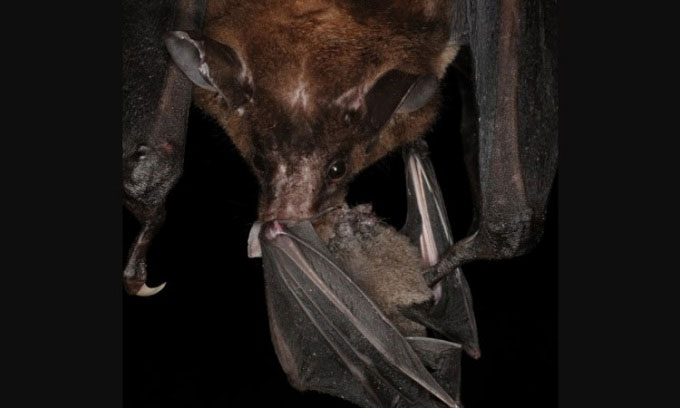Specter bats specialize in cannibalism
Ghost bats are likened to jaguars with wings because they also kill their prey with a fatal bite on the top of the head or the back of the neck like a leopard.
Winifred Frick, scientific director of the nonprofit Bat Conservation International and California ecologist Santa Cruz, examines nets during this year's Belize bat survey. During the expedition in November, the team encountered dozens of species of bats near the Lamanai archaeological reserve, but none larger than a song sparrow. But the Vampyrum spectrum, the size of a crow, is the largest bat species in the Western Hemisphere, with a wingspan that can exceed a meter.

Ghost bat eats another bat.
Ghost bats are sometimes called pseudo-vampire bats because they don't suck blood, but eat raw meat. This top predator hunts mice, birds and other bats, sometimes attacking their prey mid-flight. Therefore, Frick, who has handled thousands of bats for 20 years, carefully wears thick leather gloves to avoid being bitten.
The week before, another team of netting had caught a female ghost bat. When she removed the bat from the net for a closer look, Frick was surprised to see rows of holes in each wing, indicating that this was the bat her colleague had caught earlier. Hole shooting is a quick and harmless research method for obtaining genetic specimens. The skin will heal quickly and will not affect flight operations.
"Bats are an important part of mammal biodiversity. In particular, ghost bats are a great example. They are winged leopards in the rainforests of Central and South America," Frick said.
Melissa Ingala, a research fellow at the American Museum of Natural History in New York, and her colleagues placed a microscopic tag under the bat's skin and took a stool sample to determine what it had eaten recently. If the bat was caught again, the team could compare the two specimens to see how its diet changed. This is important information about the animal's behavior.
Bats usually eat insects, fruit or pollen, but recent research shows that ghost bats are one of nine types of bats that can be classified as carnivores. These bats are the top predators in the ecosystem, contributing to the control of bait populations.
From southern Mexico to Brazil, ghost bats fly through the night in search of birds, capturing prey perched on tree branches or in nests. This flying sucker also catches mice wandering among the fallen leaves. Like jaguars, they often take a fatal bite to the top of the head or the back of their prey. However, scientists rarely see ghost bats hunting because their density is very low. Habitat loss is also a serious problem. The International Union for Conservation of Nature classifies ghost bats as threatened with extinction.
- Discover the species of bat that catch ... fish
- Pelican-like spiders specialize in cannibalism
- How do bats spread disease globally?
- Discover new bats on dogs in Panama and Ecuador
- Terrible hot sun causes bats to fall like a fig in Australia
- Discover panda bat in South Sudan
- The owner cried when he discovered 1,700 bats crawling, occupying the balcony to ... 'pleasure'
- Discover 4 strange bat species
- New discoveries about bats: Male bats use food to propose
- Why do bat hang upside down when sleeping?
- Famous novelist predicts cannibalism
- Two-headed bat carcasses in Brazil shocked the experts
 Animal 'suffering' after hibernation
Animal 'suffering' after hibernation Why do goats climb well?
Why do goats climb well? Scientists were surprised to see chimpanzees eating turtles
Scientists were surprised to see chimpanzees eating turtles Giant catfish died deadly due to drought in Thailand
Giant catfish died deadly due to drought in Thailand